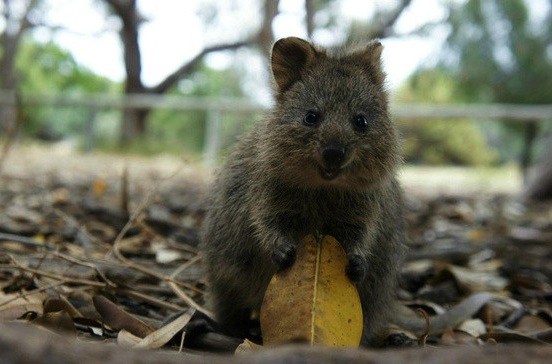|
By Alexandra DeCandia
With an ever-increasing frequency, one pudgy little macropod marsupial is making headlines. Proclaimed the “Happiest Animal in the World” by Huffington Post some ten months ago, the quokka has since bundled into millions of hearts with its teddy-bear frame, cheeky grin, and characteristically social nature. Despite its near constant appearance on internet forums such as BuzzFeed and Reddit’s r/Aww, though, public awareness of the modern risks to quokka populations remains low. Quokkas are one of the many species listed as vulnerable on IUCN’s Redlist (a wildlife conservation database). Due to their extreme endemism in the southwest corner of Australia and its two abutting islands (Rottnest and Bald), quokkas are particularly sensitive to habitat fragmentation, destruction, and climatic alteration. Unfortunately, as a result of human activities, quokka populations now face all three such threats. In fact, in a study conducted by Lesley Gibson et al. (2010), extinction is estimated to occur as early as 2070 if steps aren’t taken to drastically mitigate the species’ decline. In order to combat threats afflicting native species, it is crucial for scientists to understand the exact causes of projected population declines. For quokkas, these causes are directly linked to their preferred habitats. In Australia, a continent marked by deserts and aridity, quokkas thrive as vegetative specialists. Nocturnal foragers, these herbivorous wallaby-relatives seek dense, shrubbery-laden habitats near swamps to permanently lodge their societies of 25-150 individuals. Historically, these habitats occurred in regions with 700 mm of annual rainfall. However, recent quokka populations have shifted to reside in areas receiving over 1000 mm of rain per annum as a defense mechanism. Small and ill-equipped to fend off predators with their chubby cheeks and tiny paws, quokkas rely on rain-fed vegetation for protection as well as nutrition. Seeking ample rainfall in an arid locale may not seem a winning strategy, but it is one that has obscured quokkas from dingoes, foxes, cats, and even large birds for millions of years. As humans alter the environment in unprecedented ways, though, the quokka’s strategy may no longer apply. Foremost among risks to quokkas lies climate change. With the continued outpouring of anthropogenic greenhouse gases into the atmosphere, the overall temperature of our planet is increasing. For some areas, such as the northeastern United States, climate change will bring wetter conditions and more frequent occurrences of super-storms. For others, such as the entire continent of Australia, climate change spells increased heat-indices and ultimate desertification. Even the mildest models examining these rainfall alterations and projected quokka distributions predict ultimate range restriction. The most extreme models foresee extinction within our lifetime. Without dense vegetation afforded by ample rainfall, quokkas will be unable to defend against natural and introduced predators. Ultimately, they will be hunted to extinction as desert and suburbia afford little protection. However, despite the gloom-and-doom nature of this Holocene Extinction, there exists hope for the quokka moving forward. In the best-case scenario, mankind can halt climate change, eradicate introduced predators, reconnect fragmented habitats, and expand the quokka’s current range to encompass greater (and wetter) regions. In a more realistic scenario, man can limit further greenhouse gas emissions, control invasive predator populations, conserve existing habitat, and design an action plan for species relocation should their current range ultimately disappear. The bottom line is that quokkas do not have to die. Steps can be taken towards their protection. The quokka is just one species currently staring at the face of extinction. As human populations continue to grow at astronomical rates, it becomes our duty protect those we have harmed in our meteoric rise. Studying the effects of climate change on endemic species and managing their recovery programs before their necessary institution is and should be our present reality. Otherwise, we risk the loss of those species that make this planet worth the fight. Otherwise, we risk the loss of that contagious smile of the world’s happiest animal.
0 Comments
Leave a Reply. |
Categories
All
Archives
April 2024
|

